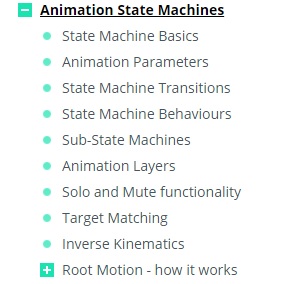 • Unity AI Game Programming.
• Chapter 2: Finite State Machines and You.
Discusses a way of simplifying how we manage the decisions,
which AI needs to make. We use FSMs to determine how AI
behaves in a particular state and how it transitions to other states.
• Unity AI Game Programming.
• Chapter 2: Finite State Machines and You.
Discusses a way of simplifying how we manage the decisions,
which AI needs to make. We use FSMs to determine how AI
behaves in a particular state and how it transitions to other states.
• Understanding Unity's state machine features
• Creating our own states and transitions
• Creating a sample scene using examples
 • Animation State Machines.
It is common for a character or other animated Game Object to have
several different animations that correspond to different actions
it can perform in the game. For example, a character may breathe or
sway slightly while idle, walk when commanded to and raise its arms
in panic as it falls from a platform. A door may have animations for
opening, closing, getting jammed, and being broken open. Mecanim uses
a visual layout system similar to a flow-chart, to represent a state
machine to enable you to control and sequence the animation clips that
you want to use on your character or object. This section gives further
details about Mecanim’s state machines and explains how to use them.
• Animation State Machines.
It is common for a character or other animated Game Object to have
several different animations that correspond to different actions
it can perform in the game. For example, a character may breathe or
sway slightly while idle, walk when commanded to and raise its arms
in panic as it falls from a platform. A door may have animations for
opening, closing, getting jammed, and being broken open. Mecanim uses
a visual layout system similar to a flow-chart, to represent a state
machine to enable you to control and sequence the animation clips that
you want to use on your character or object. This section gives further
details about Mecanim’s state machines and explains how to use them.
 • Adding Random Gameplay Elements.
Randomly chosen items or values are important in many games.
This sections shows how you can use Unity’s built-in random
functions to implement some common game mechanics.
• Adding Random Gameplay Elements.
Randomly chosen items or values are important in many games.
This sections shows how you can use Unity’s built-in random
functions to implement some common game mechanics.
• Youtube AAV Week 9.

 • Digital Tutors - Introduction to Unity 5.
• 18 Setting up the enemy.
09:22
• Digital Tutors - Introduction to Unity 5.
• 18 Setting up the enemy.
09:22
 • Digital Tutors - Introduction to Unity 5.
• 19 Setting up the enemy movement.
10:56
• Digital Tutors - Introduction to Unity 5.
• 19 Setting up the enemy movement.
10:56
 • Digital Tutors - Introduction to Unity 5.
• 20 Creating pickups..
13:56
• Digital Tutors - Introduction to Unity 5.
• 20 Creating pickups..
13:56
 • Digital Tutors - Introduction to Unity 5.
• 21 Creating the game state.
11:43
• Digital Tutors - Introduction to Unity 5.
• 21 Creating the game state.
11:43
 • Unity Tutorials - Navigation.
Find out about Unity's 'Nav Mesh' pathfinding system.
• Unity Tutorials - Navigation.
Find out about Unity's 'Nav Mesh' pathfinding system.








